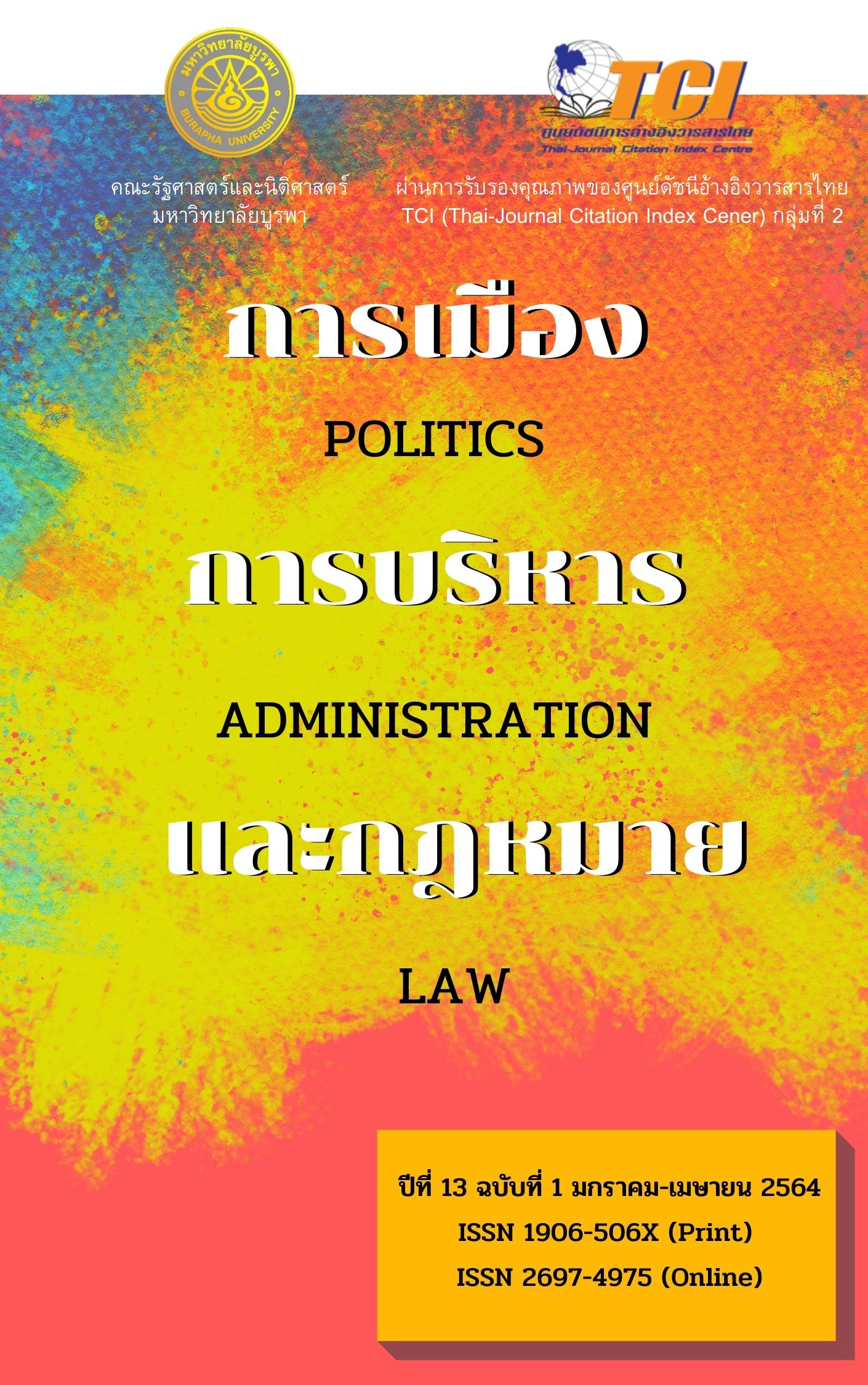สมรรถนะของแรงงานในนิคมอุตสาหกรรมอมตะซิตี้ ชลบุรี
คำสำคัญ:
สมรรถนะของแรงงาน, การพัฒนาแรงงานบทคัดย่อ
การวิจัยครั้งนี้มีวัตถุประสงค์เพื่อ (1) เพื่อศึกษามาตรการของรัฐบาลในการพัฒนาแรงงานในนิคมอุตสาหกรรมอมตะซิตี้ ชลบุรี (2) เพื่อศึกษาปัจจัยที่มีอิทธิพลต่อสมรรถนะของแรงงานในนิคมอุตสาหกรรมอมตะซิตี้ ชลบุรี และ (3) เพื่อเสนอแนวทางในการปรับปรุงการพัฒนาแรงงานของรัฐบาล รวมทั้งการประยุกต์ใช้ในองค์การต่างๆทั้งในภาครัฐและภาคเอกชน การศึกษาแบ่งเป็นการศึกษาวิจัยเชิงคุณภาพจากเอกสารทางราชการ งานวิจัยและการสัมภาษณ์ผู้เกี่ยวข้องที่เชื่อถือได้เพื่อตอบคำถามการวิจัยข้อที่ 1. รัฐบาลมีมาตรการอะไรบ้างในการพัฒนาแรงงานและส่งผลอย่างไรต่อแรงงานในนิคมอุตสาหกรรมอมตะซิตี้ ชลบุรี และการศึกษาเชิงปริมาณโดยการสำรวจข้อมูลระดับปัจเจกบุคคลของแรงงานในนิคมอุตสาหกรรมอมซิตี้ ชลบุรี เพื่อตอบคำถามการวิจัยข้อที่ 2. ปัจจัยการพัฒนาแรงงานมีอิทธิพลต่อสมรรถนะของแรงงานในนิคมอุตสาหกรรมอมตะซิตี้ ชลบุรี อย่างไร และ 3. มีปัจจัยอะไรบ้างที่มีอิทธิพลต่อสมรรถนะของแรงงาน ในนิคมอุตสาหกรรมอมตะซิตี้ ชลบุรี จากตัวอย่างประชากร 385 ตัวอย่าง ผู้วิจัยได้นำข้อมูลจากแบบสอบถามใช้การวิเคราะห์ข้อมูลภูมิหลัง โดยใช้สถิติเชิงพรรณา ค่าร้อยละ ค่าเฉลี่ย และค่าเบี่ยงเบนมาตราฐาน การวิเคราะห์เพื่อทดสอบหาความแตกต่างของค่าเฉลี่ยของตัวแปร (One-way ANOVA) การวิเคราะห์ความสัมพันธ์ระหว่างตัวแปร (correlations) และการวิเคราะห์หารูปแบบความสัมพันธ์ระหว่างตัวแปร (multiple-regression) ผลการวิจัย พบว่า 1. มาตรการของรัฐบาลในการพัฒนาสมรรถนะของพนักงานในโรงงานอุตสาหกรรมอมตะซิตี้ ชลบุรี ประกอบ ด้วย (1) การฝึกอบรมพัฒนาฝีมือแรงงาน (2) การทดสอบมาตรฐานฝีมือแรงงาน (3) ค่าจ้างตามมาตรฐานฝีมือแรงงาน (4) สิทธิประโยชน์ด้านภาษี และ (5) กองทุนพัฒนาฝีมือแรงงาน (6) การประชาสัมพันธ์ 2. ปัจจัยที่มีอิทธิพลต่อสมรรถนะในการทำงานของพนักงานโรงงานในนิคมอุตสาหกรรมอมตะซิตี้ ชลบุรี ประกอบด้วย การพัฒนาแรงงาน ทัศนคติในการทำงาน แรงจูงใจในการทำงาน และความพึงพอใจในการทำงานมีความสัมพันธ์เชิงบวกต่อสมรรถนะในการทำงานอย่างมีนัยสำคัญทางสถิติที่ระดับ 0.01 3. ปัจจัยที่ประกอบด้วย ทัศนคติในการทำงาน แรงจูงใจในการทำงานและความพึงพอใจในการทำงาน สามารถร่วมกันทำนายตัวแปรตาม คือสมรรถนะในการทำงาน ได้ร้อยละ 52.8 โดยสามารถหารูปแบบความสัมพันธ์ระหว่างตัวแปรและสามารถสร้างเป็นสมการแสดงความสัมพันธ์ระหว่างตัวแปรอิสระกับตัวแปรตามได้ 4. ข้อเสนอแนะ ในเชิงทฤษฎีมีข้อค้นพบจากการวิจัยที่มีส่วนในการเพิ่มองค์ความรู้ให้กับวิชาการด้านรัฐประศาสนศาสตร์ใน 3 ประการคือ 1) ปัจจัยที่เกิดจากการพัฒนาแรงงานของรัฐบาลที่มีผลต่อสมรรถนะของแรงงาน 2) มาตรการที่ยังทำได้ไม่สมบูรณ์คือ การประชาสัมพันธ์ และการกำหนดเป้าหมาย และ 3) ยังมีปัจจัยสำคัญอื่นๆ ที่มีผลต่อสมรรถนะของแรงงาน ที่มาตรการของภาครัฐยังไม่ครอบคลุม คือทัศนคติ แรงจูงใจในและความพึงพอใจในการทำงาน ในเชิงปฎิบัติเสนอว่า ควรให้สหภาพแรงงานเข้ามามีบทบาทที่จะคอยดูแลผลประโยชน์ให้กับแรงงานในด้านการพัฒนาให้มากขึ้น โดยใช้กลไกลของสหภาพแรงงานเข้ามาเสริมในด้านการสื่อสารประชาสัมพันธ์และการรักษาสิทธิของแรงงาน
เอกสารอ้างอิง
กระทรวงแรงงาน. (2559). กรอบยุทธศาสตร์การพัฒนาทรัพยากรมนุษย์ของประเทศ ระยะ 20 ปี. วันที่ค้น ข้อมูล 15 สิงหาคม 2562, เข้าถึงได้จาก https://www.nstda.or.th/th/nstda-doc-archives/thailand-40/11704-ministryoflabour
กระทรวงอุตสาหกรรม. (2560). นโยบายรัฐบาล. วันที่ค้นข้อมูล 15 ตุลาคม 2561, เข้าถึงได้จาก http://www.industry.go.th/om1/index.php/2016-04-21-07-47-44/2016-04-21-07-50-10
จุฬาลงกรณ์มหาวิทยาลัย, คณะเศรษฐศาสตร์. (2553). โครงการจัดจ้างที่ปรึกษาเพื่อศึกษาวิเคราะห์แนวทางการพัฒนากำลังคนที่สอดคล้องกับการลงทุนตามแผนปฏิบัติการไทยเข้มแข็ง 2555 และการปรับกลไกการบริหารงานโดยกรมพัฒนาฝีมือแรงงาน 2553. กรุงเทพฯ: คณะเศรษฐศาสตร์จุฬาลงกรณ์มหาวิทยาลัย.
นาถรพี ชัยมงคล และคณะ. (2550). ปัจจัยที่มีผลต่อการฝึกยกระดับฝีมือแรงงาน: กรณีศึกษาเปรียบเทียบแรงงานในเขตกรุงเทพมหานคร/ ปริมณฑลและเขตนิคมอุตสาหกรรมภาคตะวันออก. กรมพัฒนาฝีมือแรงงาน กระทรวงแรงงาน ดําเนินการโดย มหาวิทยาลัยเทคโนโลยีราชมงคลธัญบุรี.
ระพีพรรณ คําหอม. (2539). ความต้องการแรงงานและความพร้อมในการมีส่วนร่วมกับภาครัฐในการพัฒนาฝึมือแรงงานของสถานประกอบการทั่วประเทศ. กรุงเทพฯ: คณะสังคมสงเคราะห์ศาสตร์ มหาวิทยาลัยธรรมศาสตร์.
วราธร ปัญญางาม นายคึกฤทธิ์ พรมสุ้ย และศุภัชญา โชตยะกุล. (2560). การจัดทำสถิติผลิตภาพแรงงานในสถานประกอบกิจการที่จัดฝึกอบรมตามพระราชบัญญัติส่งเสริมการพัฒนาฝีมือแรงงาน พ.ศ. 2545. กรุงเทพฯ: กรมพัฒนาฝีมือแรงงาน กระทรวงแรงงาน.
ศิริวรรณ เสรีรัตน์, สมชาย หิรัญกิติ และธนวรรธ ตั้งสินทรัพย์สิริ. (2550). การจัดการ-และพฤติกรรมองค์การ. กรุงเทพฯ: Diamond In Business World.
สำนักงานคณะกรรมการข้าราชการพลเรือน. (2551). สมรรถนะของราชการพลเรือนไทยกรมการปกครอง. วันที่ค้นข้อมูล 15 สิงหาคม 2562, เข้าถึงได้จาก http//www.dopa.go.th
Boyatzis, R. E. (2011). Managerial and Leadership Competencies: a Behavioral Approach to Emotional, Social and Cognitive Intelligence. The Journal of Business Perspective, 15(2), 91-100.
Creswell, J. W. (1998). Qualitative inquiry and research design: Choosing among five traditions. London: Sage Publications.
Dugguh, S. I., & Dennis, A. (2014). Job satisfaction theories: Traceability to employee performance in organizations. Journal of Business and Management, 16(5), 11-18.
Guilford, J., & Gray, D. E. (1970). Motivation and Modern Management. Massachusetts: Addison-Wesley Publishers.
Herzberg, F., Mausner, B., & Snyderman, B. (1959). The motivation to work. New York: John Wiley & Wiley.
Kretch, D., & Crutchfield, R. S. (1948). Theory and problems of social psychology. New York: McGraw-Hill.
Ledford, G. E. (1995). Paying for the skills, knowledge, and competencies of knowledge workers. Compensation & Benefits Review, 27(4), 55-62.
Lizzio, A., & Wilson, K. (2004). Action learning in higher education: An investigation of its potential to develop professional capability. Studies in Higher Education, 29, 469-488.
Lucia, A. D., & Lepsinger, R. (1999). The art and science of competency models: Pinpointing critical success factors in organizations. New York: Pfeiffer.
Maslow, A. H. (1954). Motivation and personality. New York: Harper & Row.
McClelland, D. C. (1961). The Achievement Society. New York: Prentice - Hall.
McClelland, D.C. (1973). Business Drive and National Achievement. Harvard Business Review, 22(4), 99-122.
Mondy, R. W., Noe, R. M., & Premeaux, S. R. (2002). Human resource management (7th. ed.). Upper Saddle River, NJ: Prentice Hall.
Parry, S. (1996). Evaluating the impact of training. Alexandria, VA: American Society for Training and Development.
Peter, S. (2008). Labour Perspectives on the New Politics of Skill and Competency Formation: International Reflections. Asia Pacific Education Review, 9(1), 50-62.
Sandberg, J. (2000). Understanding human competence at work: An interpretative approach. The Academy of Management Journal, 43(1), 9-25.
Spencer, L. M., & Spencer, S. M. (1993). Competence at work: Model for superior performance. New York: John Wiley & Sons.
Stake, R. E. (1995). The art of case study research. Thousand Oaks, CA: Sage
Yamane, T. (1973). Statistics, Introductory Analysis. (3rd ed.). New York: Harper and Row.
ดาวน์โหลด
เผยแพร่แล้ว
ฉบับ
ประเภทบทความ
สัญญาอนุญาต

อนุญาตภายใต้เงื่อนไข Creative Commons Attribution-NonCommercial-NoDerivatives 4.0 International License.






